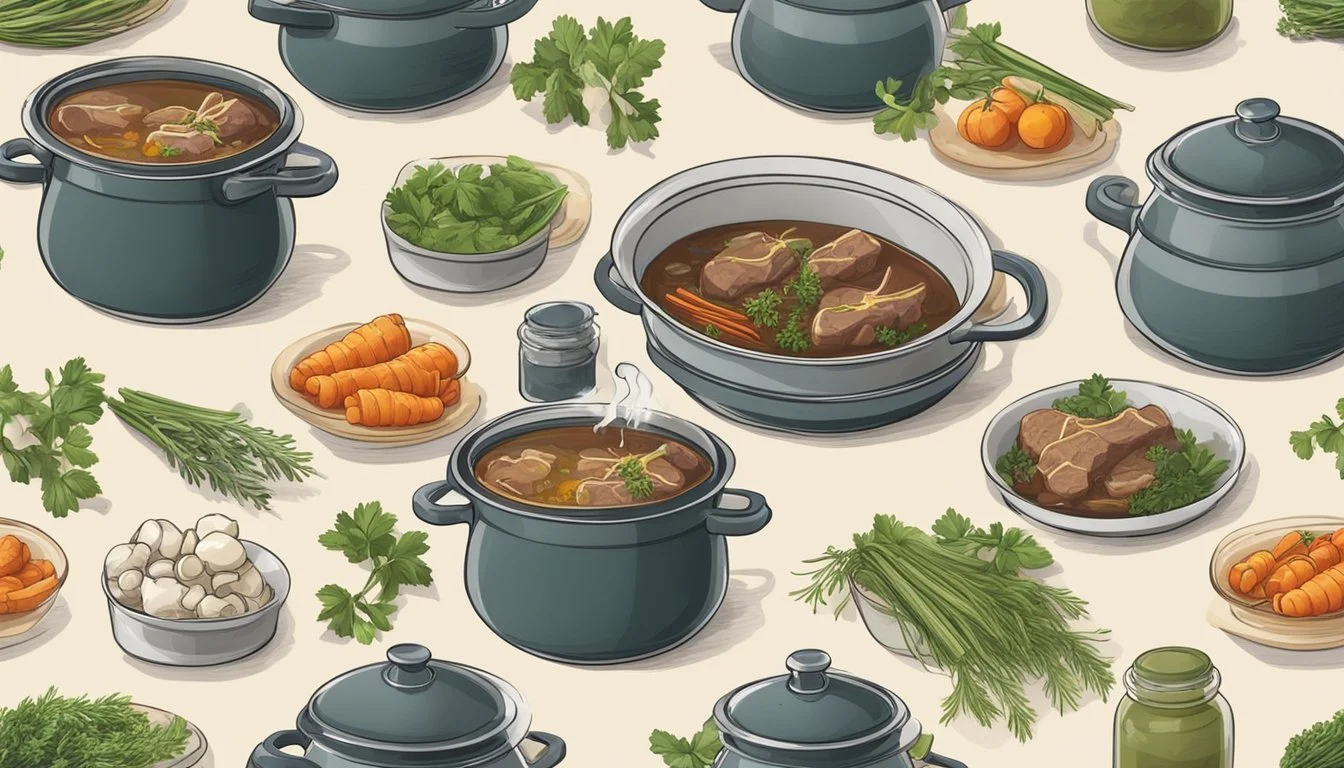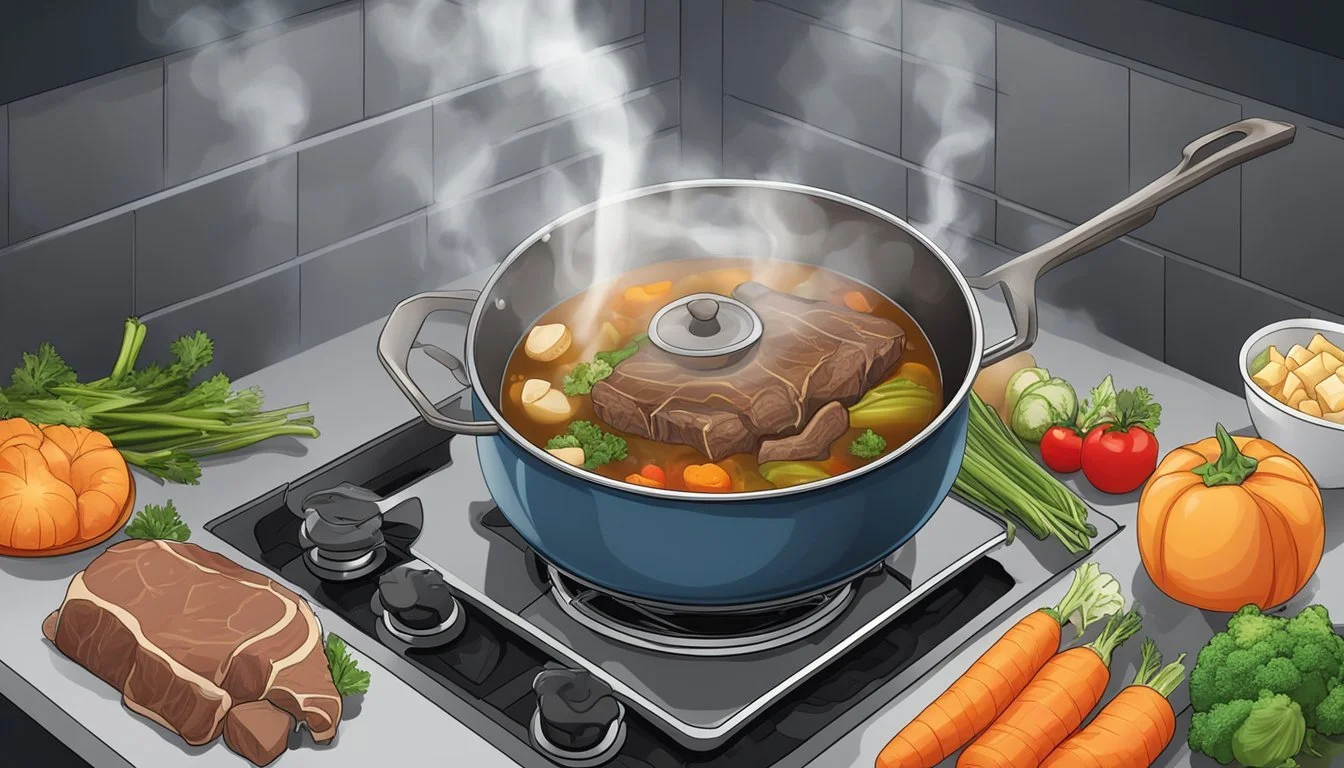The Ultimate Guide to Making Beef Bone Broth Gummy Snacks
Simple Steps for Nutritious Bites
Beef (What wine goes well with beef?) bone broth gummy snacks (What wine goes well with snacks?) may sound unconventional, but they offer a unique way to enjoy the nutritional benefits of bone broth in a convenient and playful form. These gummies provide an excellent source of protein, are rich in collagen, and can be a satisfying savory treat for those looking for a healthier snack option. Combining the hearty essence of bone broth with the fun texture of gummies makes for a novel culinary creation that is both nourishing and delightful.
The process for making these snacks is a fusion of traditional bone broth preparation and the simple technique of making gelatin-based treats. A well-made beef bone broth serves as the base, brimming with flavors derived from hours of simmering bones, herbs, and vegetables. Once the broth is prepared, it is blended with gelatin to set into a gummy consistency. This method preserves the broth's rich taste and healthful attributes, ensuring the snacks are loaded with the goodness of homemade bone broth.
Creating beef bone broth gummy snacks involves a few key steps that ensure their successful outcome. It starts with roasting quality beef bones to deepen their flavor, then simmering them with carefully selected ingredients to extract maximum nutrients. The resulting broth is then transformed with gelatin into gummies, offering a portable and tasty way to reap the benefits of bone broth. Whether as a quick snack on the go or a healthful addition to one's dietary regimen, these gummy snacks are a creative and enjoyable way to incorporate bone broth into everyday life.
Understanding Bone Broth
Bone broth is a nutrient-dense liquid, rich in protein and minerals, whose origins date back centuries as a health tonic. This section details its history, nutritional content, and the distinctions between different types.
History and Benefits of Bone Broth
Historically, bone broth has been a staple in many cultures' diets due to its robust nutritional profile and ability to utilize every part of an animal. It is renowned for its high collagen content, which is instrumental in promoting healthy joints and digestion. Consuming bone broth provides essential amino acids, such as glycine, which are the building blocks of protein and vital for many bodily functions.
Nutrients commonly found in bone broth:
Protein: Supports tissue repair and muscle growth.
Vitamins: B vitamins, among others, are present and contribute to energy production.
Minerals: Calcium, magnesium, and phosphorus support bone health.
Collagen: Converts into gelatin when cooked and supports skin, hair, nail, and joint health.
Amino Acids: Glycine and proline aid in digestion and improve sleep quality.
Comparing Beef, Chicken, Turkey, and Pork Bone Broth
Each type of bone broth presents a unique nutrient profile and flavor:
Beef Bone Broth: Typically rich in flavor, it contains ample amounts of gelatin, which may result in a thicker consistency. It often contains higher levels of amino acids and is considered particularly nourishing for joints.
Chicken Bone Broth: Known for being lighter and easier to digest, chicken bone broth is an excellent source of protein and is commonly recommended for its purported immune-boosting properties.
Turkey Bone Broth: Similar to chicken but with a different flavor profile, turkey broth is often recommended during the colder months and is associated with comfort foods.
Pork Bone Broth: Less common but highly nutritious, pork broth offers a different spectrum of vitamins and minerals and can be a rich addition to one's diet.
He, she, or they can benefit from bone broth as it encompasses various nutrients essential for maintaining a healthy body. Enthusiasts of nutritious and wholesome diets often include different types of bone broths to reap the diverse health benefits each offers.
Ingredients for a Rich Broth
Creating a rich beef bone broth requires careful selection of both bones and complementary ingredients. The quality of the bones and the blend of vegetables and herbs are pivotal for a broth that not only tastes good but also sets into gummy snacks with a concentrated flavor.
Selecting Quality Beef Bones
For a broth that is both rich in flavor and nutrients, one should opt for a variety of beef bones. Marrow bones and knuckles contribute to a gelatinous consistency, essential for gummy snacks. Short ribs and oxtail add depth to the flavor profile. It's advisable to source bones from a trusted butcher to ensure the beef used is of the highest quality.
Bone Type Characteristics Contribution to Broth Marrow Bones High in marrow Richness, Nutrients Knuckles Gelatin-rich Gelatinous Consistency Short Ribs Flavorful meat attached Depth of Flavor Oxtail Mix of meat and marrow Flavor and Body
Vegetables and Herbs to Enhance Flavor
The addition of vegetables and herbs is fundamental to achieve a full-bodied broth. Onions, carrots, and celery act as aromatic bases, providing both sweetness and earthiness. Garlic imparts an umami depth which can be crucial when concentrations are increased for gummy snacks. Fresh herbs, such as bay leaves, peppercorns, rosemary, and thyme, offer a complex bouquet of flavors:
Carrots, onions, and celery - Foundation for a hearty umami flavor.
Garlic - Adds subtlety and richness.
Bay leaves and peppercorns - Introduce a warm, peppery aroma.
Rosemary and thyme - Infuse the broth with a woodsy, fragrant quality.
Using fresh herbs is preferable, as they retain more of their essential oils and potency. Including these ingredients adds not just taste but also beneficial nutrients to the broth.
The Cooking Process
The success of beef bone broth gummy snacks hinges on a meticulous cooking process that begins with roasting the bones to enrich the broth's flavor and ends with an expert blend of seasonings and spices. This section emphasizes each critical stage to ensure a wholesome and tasty result.
Roasting Bones for a Deeper Flavor
One begins by preheating the oven to 450°F. The beef bones must lay in a single layer in roasting pans to ensure even cooking. The roasting duration is usually between 20 to 60 minutes, depending on the size and density of the bones. This crucial step helps in releasing impurities and contributes significantly to the broth’s rich, savory flavor profile.
Simmering to Extract Nutrients
Post-roasting, the bones should be transferred to a stock pot or a slow cooker. They are then covered with cold, filtered water to which a generous splash of apple cider vinegar is added; the acid helps in extracting nutrients from the bones. One can let the stock pot simmer on the stove for about 8-12 hours or set the slow cooker on low for an extended period of up to 16-18 hours to allow a full range of minerals and gelatin to seep into the broth.
Seasonings and Spices to Taste
Toward the end of the simmering phase, one can introduce various seasonings and spices to the broth for added flavor. Common choices include salt, fresh or dried herbs, and aromatic vegetables like celery or fennel. It is crucial to consider that the broth will later be used for gummies; thus, flavor intensity should be adjusted to complement the snack's eventual taste profile. After the cooking process, the broth must be strained to ensure clarity and smoothness in the final gummy snacks.
Broth Cooking Techniques
Selecting the right cooking method for beef bone broth is crucial to achieving a rich flavor and the perfect gelatinous texture desired for gummy snacks. Three effective methods are the slow cooker, stovetop, and pressure cooker, each catering to different preferences and time constraints.
Slow Cooker Method for Convenience
Using a slow cooker is ideal for those who prefer a "set it and forget it" approach. It is straightforward:
Roast bones at 450°F for 20 minutes to deepen the flavor.
Place roasted bones into the slow cooker.
Add seasonings such as bay leaves, ginger, and turmeric.
Pour in enough water to cover the ingredients.
Cook on low for 16-18 hours.
The slow cooker method gently extracts nutrients, making it a hassle-free experience.
Stovetop Method for Traditionalists
For purists who favor tradition, the stovetop remains a classic method:
Start by roasting bones similarly to enhance the broth’s savoriness.
Transfer bones into a large pot.
Incorporate aromatic vegetables and herbs for added depth.
Cover with water and slowly bring to a simmer.
Maintain a low simmer, skimming any impurities that rise to the top, for 12-24 hours.
The stovetop approach is rewarding as it allows chefs to interact with the broth and adjust flavors as needed.
Using a Pressure Cooker
For those seeking efficiency without compromise, a pressure cooker or Instant Pot is a time-saving godsend:
Roast bones first if a deeper flavor is desired.
Place the bones in the pressure cooker.
Add water, seasonings, and a dash of apple cider vinegar to help leach minerals from the bones.
Seal the cooker and set it to high pressure for 2 hours.
The high-pressure environment significantly reduces cooking time while producing a broth comparable in quality to the longer methods.
Finishing and Storing the Broth
Once the bone broth is fully simmered to extract nutrients from the bones, finishing it properly and storing it effectively maximizes its shelf life, ensuring it's ready for making beef bone broth gummy snacks.
Straining and Removing Fat
The broth should be strained through a fine mesh strainer lined with cheesecloth to remove bone fragments and any large pieces of vegetables or meat. Then, allow the liquid to cool slightly. One must skim off the excess fat that rises to the top; this will ensure a clearer broth and better flavor.
Cooling and Refrigerating Your Broth
After straining, the broth needs to cool to room temperature to avoid increasing the temperature inside the refrigerator. Once cooled, transfer the broth into airtight containers. When the broth is properly chilled, it may take on a gelatinous consistency due to the collagen extracted from the bones.
Freezing for Long-Term Storage
For long-term storage, freezing the broth is the best option. Portion the broth into ice cube trays for small, easily thawed amounts or in larger containers if preferred. Label each container with the date to keep track of freshness. The broth can be stored in a freezer for up to six months, retaining its flavor and nutritional value.
Serving and Utilizing Bone Broth
Bone broth is a versatile ingredient that can enhance the flavor of various dishes. When served as a standalone or used in recipes, the reheat method and seasonings can significantly impact its taste and utility.
Reheating and Seasoning Suggestions
When reheating bone broth for consumption, it is best done slowly over low heat to preserve its flavors and nutrients. Salt and seasonings can be adjusted to personal preference, focusing on enhancing the broth's natural savory qualities. One might consider the following:
Salt: A pinch of salt can intensify the flavors.
Seasonings: Experiment with garlic powder, onion powder, or a blend of dried herbs like thyme or rosemary.
These additions should be introduced after the broth is reheated, and prior to serving, to allow for precise flavor adjustments.
Incorporating Broth into Recipes
Bone broth can be seamlessly integrated into a myriad of homemade recipes to bolster nutrition and add complexity to the dish's profile. Its use extends beyond soups to include:
Soups and Stews: Use as a base for rich, hearty soups or stews, allowing the solid ingredients to soak up the broth's flavors.
Sauces: Reduce broth to a concentrate and incorporate it into sauces for a robust taste.
Rice or Grains: Substitute water with bone broth when cooking rice or grains for added nutrients and a savory depth.
It's important for chefs to keep in mind that the broth's existing flavors will influence the overall taste of the final dish.
Making Beef Bone Broth Gummy Snacks
Beef bone broth gummy snacks offer a savory twist on a traditionally sweet treat, infusing the health benefits of bone broth, such as protein and collagen, into a convenient snack form.
Preparing the Gummy Base
To begin, one needs to make a rich and gelatinous beef bone broth, which serves as the foundation of the snack. The bone broth should be prepared by simmering roasted beef bones in water, adding flavors such as herbs, spices, and a splash of apple cider vinegar or lemon juice to help extract the collagen. After the broth has achieved a deep, golden-brown color and a concentrated flavor, one must strain it to ensure the clarity needed for gummy snacks.
Next, one should measure the broth while it's warm and mix in an appropriate amount of gelatin. The ratio is crucial here: typically, one can use 1-2 tablespoons of gelatin for each cup of broth to create the desired gummy texture. Stir the mixture until the gelatin has fully dissolved, and there are no visible granules.
Molding and Setting the Gummies
Once the gummy base is ready, it's time to pour it into molds. Silicone molds come in various shapes and are preferred for their non-stick properties and ease of use. Carefully ladle the gelatin-broth mixture into the molds, avoiding the formation of bubbles. The filled molds are then gently placed in the refrigerator to set. The setting process usually takes around one to two hours, but one can also opt to freeze the gummies for a quicker setting time. The gummies should be firm to the touch and should easily pop out of the molds once fully set.
Creative Flavor Combinations
Sweet Profiles: For a hint of natural sweetness, incorporate pureed fruit such as berries or mango into the bone broth mix. Sweet spices like cinnamon can also add a layer of flavor.
Savory Twists: For those who prefer savory snacks, one can add a few drops of Worcestershire sauce or mix herbs like rosemary into the broth before adding the gelatin.
Herbal Infusions: Enhance the gummies with health-boosting, herbal properties by steeping herbs like ginger, turmeric, or thyme into the hot broth.
By carefully selecting their ingredients, individuals can tailor these gummy snacks to fit a variety of taste preferences, from sweet and fruity to rich and savory, while retaining the nutritious benefits of beef bone broth.
Health and Nutritional Information
Beef bone broth gummy snacks combine the rich nutritional elements found in bone broth with the convenience of bite-size treats. They are packed with essential nutrients that promote overall health and well-being.
Bone Broth Nutritional Profile
Beef bone broth is renowned for its collagen content, a protein that serves as a building block for skin, hair, and nails. A single cup of bone broth typically includes around 6 grams of protein, which is significant as protein is essential for various bodily functions. In addition to protein and collagen, bone broth is a valuable source of:
Minerals: such as calcium, magnesium, potassium, and iron which are crucial for bone health and various metabolic processes.
Vitamins: The specific vitamins depend on the ingredients used but often include B vitamins and vitamin K.
Amino acids: including glycine and proline which support the body's connective tissue, digestive health, and immune system.
Table: Typical Nutritional Content per Cup of Beef Bone Broth
Nutrient Amount Protein 6 grams Collagen Varied* Calcium Varied* Magnesium Varied* Iron Varied* Potassium Varied* *Varies based on cooking time and bone type
Benefits for Skin, Hair, and Nails
Consuming bone broth gummy snacks may have specific benefits for skin, hair, and nails due to the presence of collagen. Collagen peptides found in bone broth can:
Strengthen fingernails and toenails,
Improve the skin's elasticity and hydration,
Support hair growth and strength by providing the building blocks needed.
The regular intake of these nutrients through bone broth gummies could assist in maintaining the health and appearance of skin, hair, and nails, and add to a balanced health routine.
Frequently Asked Questions
In this section, readers will find answers to their queries and guidance for embarking on the journey of making beef bone broth gummy snacks, a nutritious and convenient snack option.
Addressing Common Concerns
Q: How long does it take to make beef bone broth for gummy snacks?
A: Making homemade bone broth typically requires simmering bones for 8-12 hours to extract maximum flavor and nutrients.
Q: Can I use leftover bones to make bone broth for gummy snacks?
A: Yes, leftover bones from meals are excellent for making bone broth. Ensure they are properly cleaned and still have some connective tissues for the best results.
Q: Is the fat necessary for beef bone broth gummy snacks?
A: Fat can add flavor but may affect the firmness of the gummies. It's recommended to skim off excess fat once the broth is cooled.
Q: How do I store bone broth and how long will it last?
A: Beef bone broth can be refrigerated for up to 5 days and frozen for up to 6 months. Ensure it's properly sealed in airtight containers.
Tips for Beginners
Q: What are the essential ingredients for an easy-to-make bone broth recipe?
A: Beginners should focus on quality bones, such as marrow bones and knuckles, vegetables like onions and carrots, and acidic components like apple cider vinegar to help extract nutrients.
Q: Do I need to roast the bones first?
A: Roasting bones at 450 degrees F for 30 minutes before simmering can enhance the flavor of the broth, but it's not mandatory for gummy snacks.
Q: What is the simplest method to make beef bone broth for beginners?
A: The simplest method involves placing bones in a large pot, covering them with water, and adding a splash of vinegar. Then, bring the pot to a simmer, allowing it to cook for the required time frame while occasionally skimming the surface.
Q: Are there any special tools needed for making bone broth gummy snacks?
A: A large stockpot, slotted spoon, strainer, and gummy molds are the basic tools necessary for making bone broth gummy snacks.









